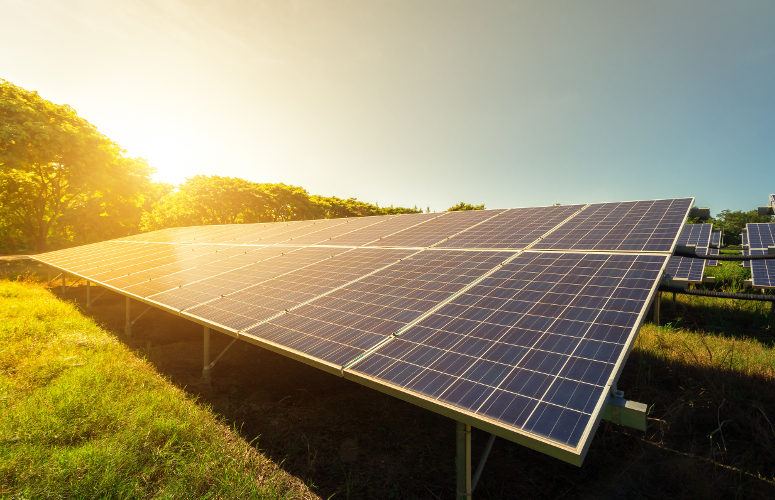
Murphy Highlights Landmark Solar Investments
On Apr 26, 2024Gov. Phil Murphy celebrated the culmination of Earth Week by unveiling a slew of new solar initiatives aimed at boosting accessibility across the board, and making solar more affordable for residents.
New Jersey already expects to surpass 200,000 solar installations in the next month and five gigawatts of installed solar capacity this year.
“Earth Week is not just a time for reflection or contemplation. It is a time for action. It is a time to take bold steps in caring for our environment and advocating for our neighbors who have endured generations of environmental injustice,” said Murphy. “New Jersey is all in on clean energy. We are on track this year to procure more solar than ever before, which will help us hit all of our solar goals, and more importantly, make solar energy more affordable and accessible than ever before while righting many wrongs of the past.”
Joined by environmental advocates, elected officials, and community and labor leaders, the Governor announced five major investments in clean energy that will contribute to the state meeting its goal of reducing emissions by 80% by 2050.
The first investment, awarded to New Jersey this week by the U.S. Environmental Protection Agency, is $156.1 million through the Solar For All competition, which is part of the historic $27 billion Greenhouse Gas Reduction Fund created under President Biden’s Inflation Reduction Act.
The funding will be leveraged to support impactful solar programs that enable low-income and disadvantaged communities to benefit from clean energy by supporting solar access for multi-family affordable housing, establishing pathways to residential solar ownership for low-income households, expanding community solar initiatives, supporting solar workforce development, and enabling critical grid upgrades to support more solar generation in New Jersey.
New Jersey’s Solar for All award is anticipated to deliver approximately 175 megawatts of solar energy to benefit 22,000 low-income households within the first five years of funding, resulting in approximately $250 million in total energy bill savings over 30 years for residents in newly connected households. Additionally, the award is expected to result in CO2 emission reductions of 240,000 short tons and enable 90 megawatt-hours of energy storage associated with multi-family housing.
The federal Solar For All program was developed through extensive engagement with key environmental, environmental justice, economic development, labor, and other stakeholder groups.
New Jersey received the highest amount awarded to states in its category.
The Governor today also detailed a sizable solar investment awarded last week by the New Jersey Board of Public Utilities (NJBPU) that will create 310 megawatts of grid-scale solar and the first state-incentivized energy storage project in New Jersey. This award marks the first successful solicitation of New Jersey’s new Competitive Solar Incentive Program, and the largest solicitation award to date in any New Jersey solar program, following several record years in New Jersey for solar capacity installation.
Among the awards is a 95-megawatt project, which would be the largest solar project in New Jersey, by far, at the lowest cost per megawatt to ratepayers. The awards also include solar projects that will transform contaminated sites or landfills, a major redevelopment and environmental justice priority of the Murphy Administration.
Equally important, this latest solicitation will cut the cost for SREC IIs (Solar Renewable Energy Certificates) by more than half, ultimately lowering the costs for ratepayers.
Murphy proposed $40 million in his Fiscal Year 2025 budget – $15 million in State funds and $25 million from the Clean Energy Fund – to provide State matching funds to leverage millions in federal grant dollars for electric grid modernization to enable clean energy interconnection and support a strong union workforce. Additionally, these grants could support the innovative development of comprehensive and regional resilience strategies to address threats to the state’s power system infrastructure, prevent outages, enhance the resilience of the electric grid, and deploy state of the art technologies to enhance grid flexibility.
Murphy also highlighted the recently announced 225 megawatts of community solar and the re-opening of the Community Solar Energy Program for an additional 275 megawatts, which is being considered by the NJBPU Board on April 30. Through the permanent Community Solar Energy Program, New Jersey expects to see higher rates of solar project completion, increased low-to-moderate income household participation, decreased energy burdens for residents, increased municipal or public entity involvement, and continued siting of solar projects primarily on the built environment and contaminated lands.
Additionally, the NJBPU is anticipated to launch the Dual-Use Solar Pilot Program this summer, which looks to award up to 200 megawatts of solar capacity combined with active agricultural or horticultural production.
“With the launch of this project, New Jersey continues to lead the charge toward a sustainable clean energy future,” said Senator Bob Smith, Senate Environment and Energy Committee Chair. “This project not only harnesses clean energy but empowers communities, providing more accessibility to sustainable power for all residents in our state.”
The Governor made these announcements in Berkeley Township, Ocean County, where CS Energy’s new Eagle Solar I and II community solar projects are nearing completion. The 10 MW projects will power approximately 1,600 homes across the region while providing a 20% discount to all subscribers, including 51% low and moderate income (LMI) customers, a move that is expected to produce annual household savings of more than $200 and just under $7 million over the 20-year lifetime of the project for all 1,600 homes.
The first phase of the massive undertaking saw the 40-acre landfill closed and capped after roughly 40 years, at no cost to the township, representing the first time that state community solar incentives were leveraged by a solar developer to finance the closure of a former landfill. This paved the way for construction of the solar project – one of the two largest community solar projects in New Jersey – which was made possible, in large part, by support from NJBPU and collaboration with the New Jersey Department of Environmental Protection and the New Jersey Pinelands Commission.
To access more business news, visit NJB News Now.
Related Articles:





